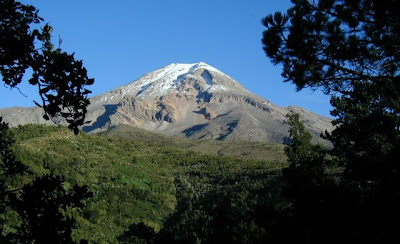The Pico de Orizaba, or Citlaltepetl is a stratovolcano, the highest mountain in Mexico and the third highest in North America. It rises 5,636 meters or 18,490 feet above sea level in the eastern end of the Eje Volcanico Transversal mountain range, on the border between the states of Veracruz and Puebla. The volcano is currently dormant but not extinct the last eruptions occurred in 1687, with previous eruptions in 1630, 1613, 1569, 1566 and 1537. It is the second most prominent volcanic peak in the world after Africa's Mount Kilimanjaro.
 The Pico overlooks the valley and city of Orizaba, from which it gets its name. The name Citlaltepetl is not used by Nahuatl speakers of the Orizaba area, who instead call it Istaktepetl in the traditional orthography for Classical Nahuatl 'White Mountain'.
The Pico overlooks the valley and city of Orizaba, from which it gets its name. The name Citlaltepetl is not used by Nahuatl speakers of the Orizaba area, who instead call it Istaktepetl in the traditional orthography for Classical Nahuatl 'White Mountain'.A regionally dominant peak, and in fact the highest peak between Colombia and the Yukon, the Pico de Orizaba is ranked 7th in the world in topographic prominence. It is the second most prominent volcanic peak in the world after Africa's Mount Kilimanjaro. Although it is about 110 km or 75 miles inland, to the west of the port of Veracruz, its peak is visible to ships approaching the port in the Gulf of Mexico, and at dawn rays of sunlight strike the Pico while Veracruz still lies in shadow. The Pico is ranked 16th in the world for topographic isolation.


 The peak is one of three volcanoes that contain permanent snow and glaciers in Mexico. The others are Popocatepetl and Iztaccihuatl. A companion peak lying about six km to the southwest of the Pico de Orizaba is the Sierra Negra, at 4,640 metres or 15,223 ft. This subsidiary peak, though far lower than its massive neighbor, is still higher than anything in the 48 contiguous states of the U.S., and on its summit, serviced by the highest road in North America, is one of the world's premier astronomical instruments, the Large Millimeter Telescope.
The peak is one of three volcanoes that contain permanent snow and glaciers in Mexico. The others are Popocatepetl and Iztaccihuatl. A companion peak lying about six km to the southwest of the Pico de Orizaba is the Sierra Negra, at 4,640 metres or 15,223 ft. This subsidiary peak, though far lower than its massive neighbor, is still higher than anything in the 48 contiguous states of the U.S., and on its summit, serviced by the highest road in North America, is one of the world's premier astronomical instruments, the Large Millimeter Telescope.The Pico de Orizaba was important in such pre-Hispanic cultures as those of the Nahuatl-speaking Aztecs and the Totonacs. The summit and its surrounding foothills are part of a national park. There are many routes for approaching and climbing the volcano, and many people visit it. For information on climbing Pico de Orizaba, search summit orizaba. Pico de Orizaba is home of the highest altitude growing pine trees in the world, which NASA are studying in order to possibly grow them somewhere outside the Earth in the future.







No comments:
Post a Comment